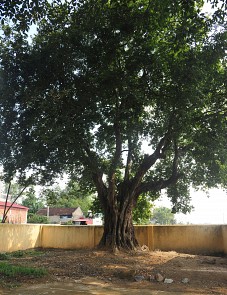Two 600-year-old trees in northern Vietnam recognized as national heritage

Dr. Do Quang Trong, director of the Center for the Conservation of the Ho Dynasty Citadel World Heritage, told Tuoi Tre (Youth) newspaper that the two trees in Xuan Giai Village were grown very long time ago, dating back to the period of the Tran-Ho Dynasties.
They were located in the center of the village and around 30 meters away from the southern moat of the citadel.
The trunks of the two trees have a circumference of 10 meters and are around 20 meters high. Their roots extend from three to five meters around the trunks.
The two trees’ canopies are very large, creating beautiful scenery for the village. They are attractive points for tourists when visiting the Ho Dynasty Citadel.
The Tran Dynasty was a ruling dynasty in Vietnam, known as Dai Viet between 1225 and 1400.
It was succeeded by the Ho Dynasty, a short-lived six-year reign of two emperors, Ho Quy Ly in 1400-1401 and his second son, Ho Han Thuong, who reigned from 1401 to 1406.
The Ho Dynasty Citadel was recognized by UNESCO as a world cultural heritage site in 2011.
According to UNESCO, the Citadel of the Ho Dynasty built in 1397 and composed of the Inner Citadel, the La Thanh Outer Wall, and the Nam Giao Altar covers 155.5 hectares, surrounded by a buffer zone of 5078.5 hectares.
It is located in accordance with geomantic principles in a landscape of great scenic beauty between the Ma and Buoi Rivers in Vinh Loc District, Thanh Hoa Province.
What the stars mean:
★ Poor ★ ★ Promising ★★★ Good ★★★★ Very good ★★★★★ Exceptional
Latest News
More News
- Swing for the Kids 2024 tees up opportunities for Vietnam's youth (October 12, 2024 | 10:00)
- HCM City approves 9 billion-USD Can Gio coastal urban development project (October 08, 2024 | 15:56)
- Nha Trang Bay submarine services pilot programme extended to next March (October 08, 2024 | 15:45)
- Swing for the Kids scholarship motivated by beneficiary’s kindness and maturity (October 08, 2024 | 12:35)
- Inflation takes focus to circumvent typhoon impact (October 04, 2024 | 17:06)
- Hanoi sets sights on becoming innovation hub (October 02, 2024 | 10:00)
- Experts discuss dengue fever prevention in Vietnam (October 01, 2024 | 17:04)
- Vietnam’s economy on track for 6.5 per cent growth despite Typhoon Yagi, says HSBC (October 01, 2024 | 16:46)
- Leadership focused on economic progress (October 01, 2024 | 10:00)
- IMF predicts Vietnam's economic growth to reach 6.1 per cent in 2024 (September 30, 2024 | 18:26)

















 Mobile Version
Mobile Version